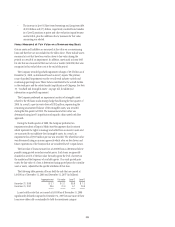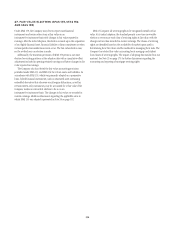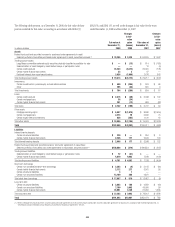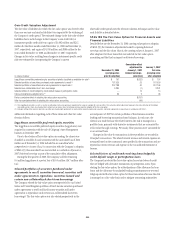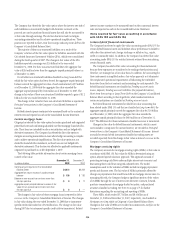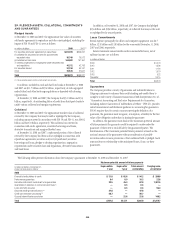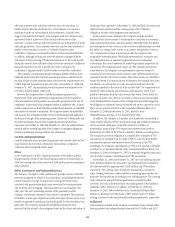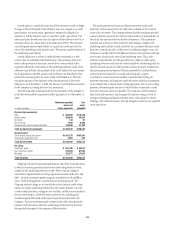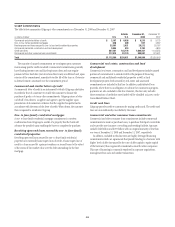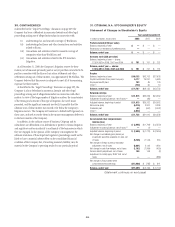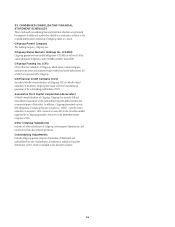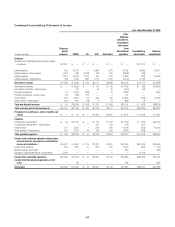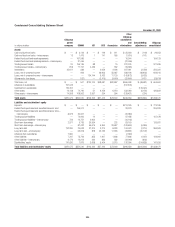Citibank 2008 Annual Report Download - page 216
Download and view the complete annual report
Please find page 216 of the 2008 Citibank annual report below. You can navigate through the pages in the report by either clicking on the pages listed below, or by using the keyword search tool below to find specific information within the annual report.offset any payments with cash flows otherwise due to the merchant. To
further mitigate this risk, the third party or the Company may require a
merchant to make an escrow deposit, delay settlement, or include event
triggers to provide the third party or the Company with more financial and
operational control in the event of the financial deterioration of the
merchant, or require various credit enhancements (including letters of credit
and bank guarantees). In the unlikely event that a private label merchant is
unable to deliver products, services or a refund to its private label
cardholders, Citigroup is contingently liable to credit or refund cardholders.
In addition, although a third party holds the primary contingent liability
with respect to the processing of bankcard transactions, in the event that the
third party does not have sufficient collateral from the merchant or sufficient
financial resources of its own to provide the credit or refunds to the
cardholders, Citigroup would be liable to credit or refund the cardholders.
The Company’s maximum potential contingent liability related to both
bankcard and private label merchant processing services is estimated to be
the total volume of credit card transactions that meet the requirements to be
valid chargeback transactions at any given time. At December 31, 2008 and
December 31, 2007, this maximum potential exposure was estimated to be
$57 billion and $64 billion, respectively.
However, the Company believes that the maximum exposure is not
representative of the actual potential loss exposure based on the Company’s
historical experience and its position as a secondary guarantor (in the case of
bankcards). In most cases, this contingent liability is unlikely to arise, as most
products and services are delivered when purchased and amounts are refunded
when items are returned to merchants. The Company assesses the probability
and amount of its contingent liability related to merchant processing based on
the financial strength of the primary guarantor (in the case of bankcards) and
the extent and nature of unresolved chargebacks and its historical loss
experience. At December 31, 2008 and December 31, 2007, the estimated losses
incurred and the carrying amounts of the Company’s contingent obligations
related to merchant processing activities were immaterial.
Custody Indemnifications
Custody indemnifications are issued to guarantee that custody clients will be
made whole in the event that a third-party subcustodian or depository
institution fails to safeguard clients’ assets.
Other
In the fourth quarter of 2007, Citigroup recorded a $306 million (pretax)
charge related to certain of Visa USA’s litigation matters. As of December 31,
2008, the carrying value of the reserve was $149 million and was included in
Other liabilities.
Other Guarantees and Indemnifications
The Company, through its credit card business, provides various cardholder
protection programs on several of its card products, including programs that
provide insurance coverage for rental cars, coverage for certain losses
associated with purchased products, price protection for certain purchases
and protection for lost luggage. These guarantees are not included in the
table, since the total outstanding amount of the guarantees and the
Company’s maximum exposure to loss cannot be quantified. The protection
is limited to certain types of purchases and certain types of losses and it is not
possible to quantify the purchases that would qualify for these benefits at any
given time. The Company assesses the probability and amount of its
potential liability related to these programs based on the extent and nature of
its historical loss experience. At December 31, 2008 and 2007, the actual and
estimated losses incurred and the carrying value of the Company’s
obligations related to these programs were immaterial.
In the normal course of business, the Company provides standard
representations and warranties to counterparties in contracts in connection
with numerous transactions and also provides indemnifications that protect
the counterparties to the contracts in the event that additional taxes are owed
due either to a change in the tax law or an adverse interpretation of the tax
law. Counterparties to these transactions provide the Company with
comparable indemnifications. While such representations, warranties and
tax indemnifications are essential components of many contractual
relationships, they do not represent the underlying business purpose for the
transactions. The indemnification clauses are often standard contractual
terms related to the Company’s own performance under the terms of a
contract and are entered into in the normal course of business based on an
assessment that the risk of loss is remote. Often these clauses are intended to
ensure that terms of a contract are met at inception (for example, that loans
transferred to a counterparty in a sales transaction did in fact meet the
conditions specified in the contract at the transfer date). No compensation is
received for these standard representations and warranties, and it is not
possible to determine their fair value because they rarely, if ever, result in a
payment. In many cases, there are no stated or notional amounts included
in the indemnification clauses and the contingencies potentially triggering
the obligation to indemnify have not occurred and are not expected to occur.
There are no amounts reflected on the Consolidated Balance Sheet as of
December 31, 2008 and December 31, 2007, related to these
indemnifications and they are not included in the table.
In addition, the Company is a member of or shareholder in hundreds of
value-transfer networks (VTNs) (payment clearing and settlement systems as
well as securities exchanges) around the world. As a condition of
membership, many of these VTNs require that members stand ready to
backstop the net effect on the VTNs of a member’s default on its obligations.
The Company’s potential obligations as a shareholder or member of VTN
associations are excluded from the scope of FIN 45, since the shareholders
and members represent subordinated classes of investors in the VTNs.
Accordingly, the Company’s participation in VTNs is not reported in the table
and there are no amounts reflected on the Consolidated Balance Sheet as of
December 31, 2008 or December 31, 2007 for potential obligations that could
arise from the Company’s involvement with VTN associations.
At December 31, 2008 and December 31, 2007, the total carrying amounts
of the liabilities related to the guarantees and indemnifications included in
the table amounted to approximately $1,820 million and $700 million,
respectively. The carrying value of derivative instruments is included in
either Trading liabilities or Other liabilities, depending upon whether the
derivative was entered into for trading or non-trading purposes. The carrying
value of financial and performance guarantees is included in Other
liabilities. For loans sold with recourse, the carrying value of the liability is
included in Other liabilities. In addition, at December 31, 2008 and
December 31, 2007, Other liabilities on the Consolidated Balance Sheet
include an allowance for credit losses of $887 million and $1.25 billion
relating to letters of credit and unfunded lending commitments, respectively.
Collateral
Cash collateral available to the Company to reimburse losses realized under
these guarantees and indemnifications amounted to $33 billion and $112
210



